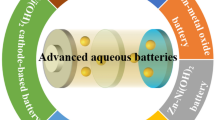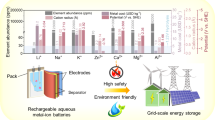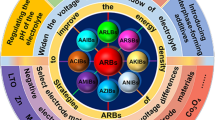Abstract
Aqueous metal-air batteries own the merits of high theoretical energy density and high safety, but suffer from electrochemical irreversibility of metal anodes (e.g., Zn, Fe, Al, and Mg) and chemical instability of alkaline electrolytes to atmospheric CO2. Here, we firstly design a rechargeable bismuth (Bi)-air battery using the non-alkaline bismuth triflate (Bi(OTf)3) aqueous electrolyte. Benefitting from the three-electron reaction and the high potential of +0.32 V vs. standard hydrogen electrode, the Bi metal anode delivers a high capacity of 383 mA h g−1 and good stability for 1000 cycles with a Coulombic efficiency of 99.6% in the Bi(OTf)3 electrolyte, without corrosion, passivation and hydrogen evolution reaction. Furthermore, the non-alkaline Bi-air battery achieves long-term operation stability (>200 h) in ambient air with the reversible formation/decomposition of bismuth trioxide (Bi2O3). This work sheds new light on the exploration of novel aqueous metal-air batteries as safe and stable power supply systems.

摘要
水系金属空气电池具有理论能量密度高、安全性高等优点, 但 受限于金属阳极(如锌、铁、铝、镁)的电化学不可逆性以及碱性电解 质对大气中二氧化碳的化学不稳定性. 本工作首次设计了一种可充电 的铋-空气电池, 该电池使用了非碱性的三氟甲磺酸铋(Bi(OTf)3)水系 电解质. 得益于三电子反应和相对于标准氢电极+0.32 V的高电位, 铋 金属负极具有383 mA h g−1的高比容量和1000次循环的良好稳定性, 以 及99.6%高库仑效率. 铋金属负极在Bi(OTf)3电解液中无腐蚀、钝化和 析氢等副反应. 此外, 非碱性的铋-空气电池通过三氧化二铋(Bi2O3)的 可逆形成/分解, 在环境空气中实现了长期运行稳定性(>200 h). 这项工 作为探索新型水系金属空气电池作为安全稳定的电源系统提供了新 思路.
Similar content being viewed by others
References
Zhu Z, Jiang T, Ali M, et al. Rechargeable batteries for grid scale energy storage. Chem Rev, 2022, 122: 16610–16751
Cano ZP, Banham D, Ye S, et al. Batteries and fuel cells for emerging electric vehicle markets. Nat Energy, 2018, 3: 279–289
Liang Y, Yao Y. Designing modern aqueous batteries. Nat Rev Mater, 2023, 8: 109–122
Duffner F, Kronemeyer N, Tübke J, et al. Post-lithium-ion battery cell production and its compatibility with lithium-ion cell production infrastructure. Nat Energy, 2021, 6: 123–134
Chao D, Zhou W, **e F, et al. Roadmap for advanced aqueous batteries: From design of materials to applications. Sci Adv, 2020, 6: eaba4098
Cheng F, Chen J. Metal-air batteries: From oxygen reduction electrochemistry to cathode catalysts. Chem Soc Rev, 2012, 41: 2172–2192
Kwak WJ, Rosy WJ, Sharon D, et al. Lithium-oxygen batteries and related systems: Potential, status, and future. Chem Rev, 2020, 120: 6626–6683
Fu J, Cano ZP, Park MG, et al. Electrically rechargeable zinc-air batteries: Progress, challenges, and perspectives. Adv Mater, 2017, 29: 1604685
Rahman MA, Wang X, Wen C. High energy density metal-air batteries: A review. J Electrochem Soc, 2013, 160: A1759–A1771
Sun W, Wang F, Zhang B, et al. A rechargeable zinc-air battery based on zinc peroxide chemistry. Science, 2021, 371: 46–51
Li L, Chen H, He E, et al. High-energy-density magnesium-air battery based on dual-layer gel electrolyte. Angew Chem Int Ed, 2021, 60: 15317–15322
Wu S, Hu S, Zhang Q, et al. Hybrid high-concentration electrolyte significantly strengthens the practicability of alkaline aluminum-air battery. Energy Storage Mater, 2020, 31: 310–317
Wu X, Markir A, Xu Y, et al. A rechargeable battery with an iron metal anode. Adv Funct Mater, 2019, 29: 1900911
Sui Y, Ji X. Anticatalytic strategies to suppress water electrolysis in aqueous batteries. Chem Rev, 2021, 121: 6654–6695
Kim H, Jeong G, Kim YU, et al. Metallic anodes for next generation secondary batteries. Chem Soc Rev, 2013, 42: 9011–9034
Sun W, Küpers V, Wang F, et al. A non-alkaline electrolyte for electrically rechargeable zinc-air batteries with long-term operation stability in ambient air. Angew Chem, 2022, 134: e202207353
Liu Q, Pan Z, Wang E, et al. Aqueous metal-air batteries: Fundamentals and applications. Energy Storage Mater, 2020, 27: 478–505
Wang ZL, Xu D, Xu JJ, et al. Oxygen electrocatalysts in metal-air batteries: From aqueous to nonaqueous electrolytes. Chem Soc Rev, 2014, 43: 7746–7786
Chang Z, Yang Y, Li M, et al. Green energy storage chemistries based on neutral aqueous electrolytes. J Mater Chem A, 2014, 2: 10739–10755
Granér F, Sillén LG. Hydrolysis of Bi3+. Oxygen bridging—A new type of ionic equilibrium. Nature, 1947, 160: 715–716
Miersch L, Rüffer T, Schlesinger M, et al. Hydrolysis studies on bismuth nitrate: Synthesis and crystallization of four novel polynuclear basic bismuth nitrates. Inorg Chem, 2012, 51: 9376–9384
Mokrai R, Barrett J, Apperley DC, et al. Tweaking the charge transfer: Bonding analysis of bismuth(III) complexes with a flexidentate phosphane ligand. Inorg Chem, 2020, 59: 8916–8924
Trummal A, Lip** L, Kaljurand I, et al. Acidity of strong acids in water and dimethyl sulfoxide. J Phys Chem A, 2016, 120: 3663–3669
Zhang H, Liu Q, Zheng D, et al. Oxygen-rich interface enables reversible stibium strip**/plating chemistry in aqueous alkaline batteries. Nat Commun, 2021, 12: 14
Ji H, Zhao X, Qiao Z, et al. Capacitance of carbon-based electrical double-layer capacitors. Nat Commun, 2014, 5: 3317
Hu ZT, Chen B, Lim TT. Single-crystalline Bi2Fe4O9 synthesized by low-temperature co-precipitation: Performance as photo- and Fenton catalysts. RSC Adv, 2014, 4: 27820–27829
Su H, Cao S, **a N, et al. Controllable growth of Bi2O3 with rod-like structures via the surfactants and its electrochemical properties. J Appl Electrochem, 2014, 44: 735–740
Acknowledgements
This work was financially supported by the Science and Technology Commission of Shanghai Municipality (STCSM, 21511104900 and 20JC1414902) and the National Natural Science Foundation of China (52222310).
Author information
Authors and Affiliations
Contributions
Author contributions Cheng X performed most experiments and characterizations and prepared the manuscript. Cheng X, Wang B, and Peng H discussed the results and co-wrote the manuscript. Jiang Y, Qu J, Li C, Zhang K and Zhang Y assisted in some experimental measurements and manuscript correction. All authors contributed to the general discussion.
Corresponding authors
Ethics declarations
Conflict of interest The authors declare that they have no conflict of interest.
Additional information
Supplementary information Supporting data are available in the online version of the paper.
**angran Cheng is currently a PhD student at the Department of Macromolecular Science, Fudan University. She received her BS degree in chemical engineering from Dalian University of Technology in 2019. Her work focuses on electrode materials, metal-air batteries, and their applications in flexible energy storage systems.
Bingjie Wang is an associate professor at the Laboratory of Advanced Materials, Fudan University. He received his BE degree in polymer materials and engineering from Sichuan University in 2009, and a PhD degree from Ningbo Institute of Materials Technology and Engineering, Chinese Academy of Sciences in 2014. His research centers on flexible energy storage devices.
Huisheng Peng is currently a university professor at the Department of Macromolecular Science and Laboratory of Advanced Materials, Fudan University. He received his BE degree in polymer materials from Donghua University in 1999, his MS degree in macromolecular chemistry and physics from Fudan University in 2003, and his PhD degree in chemical engineering from Tulane University in the USA in 2006. He then worked at Los Alamos National Laboratory before joining Fudan University in 2008. He focuses on the new direction of fiber electronics.
Supporting Information
Rights and permissions
About this article
Cite this article
Cheng, X., Jiang, Y., Qu, J. et al. A novel rechargeable aqueous bismuth-air battery. Sci. China Mater. 66, 4615–4621 (2023). https://doi.org/10.1007/s40843-023-2630-1
Received:
Accepted:
Published:
Issue Date:
DOI: https://doi.org/10.1007/s40843-023-2630-1




